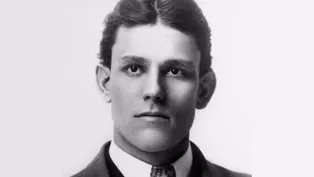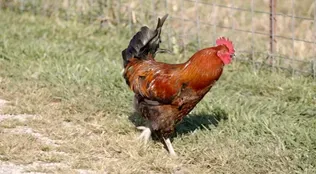Columbus Neighborhoods
Canal Winchester’s Historic Grain Elevator
Clip: Season 8 Episode 1 | 10m 7sVideo has Closed Captions
The Canal Winchester grain elevator is working on a restoration and preservation project.
The Canal Winchester Area Historical Society (CWAHS) is working on a restoration and preservation project for the 130-year-old O.P. Chaney Grain Elevator. Listed in the U.S. National Register of Historic Places, the Grain Elevator is one of the last of its age and type left in the Midwest. Architectural historian Jeff Darbee takes a tour of the building to learn more about its history, and future!
Problems with Closed Captions? Closed Captioning Feedback
Problems with Closed Captions? Closed Captioning Feedback
Columbus Neighborhoods is a local public television program presented by WOSU
Columbus Neighborhoods
Canal Winchester’s Historic Grain Elevator
Clip: Season 8 Episode 1 | 10m 7sVideo has Closed Captions
The Canal Winchester Area Historical Society (CWAHS) is working on a restoration and preservation project for the 130-year-old O.P. Chaney Grain Elevator. Listed in the U.S. National Register of Historic Places, the Grain Elevator is one of the last of its age and type left in the Midwest. Architectural historian Jeff Darbee takes a tour of the building to learn more about its history, and future!
Problems with Closed Captions? Closed Captioning Feedback
How to Watch Columbus Neighborhoods
Columbus Neighborhoods is available to stream on pbs.org and the free PBS App, available on iPhone, Apple TV, Android TV, Android smartphones, Amazon Fire TV, Amazon Fire Tablet, Roku, Samsung Smart TV, and Vizio.
Providing Support for PBS.org
Learn Moreabout PBS online sponsorshipCanal Winchester was just Winchester until the canal came through the Ohio and Erie Canal in the 1830s has been known as Canal Winchester since which suggests something of the transportation history of this community the Canal Winchester area Historical Society has done a lot to help Preserve part of that story Transportation but also local industry as well and local education so we're going to have a visit today and I think you'll find some really interesting architecture and interesting industrial and transportation history [music] well hello hi Jeff how are you good to see you welcome to the Canal Winchester historical system well thanks so much I really appreciate it so I understand we're going to see a very interesting building today we are in fact it was a grain elevator it was built by Judge John Chaney and his son op Cheney in the 1870s in 1850 Judge John Chaney and his son op founded the Empire Mill that was actually a mile away from here at about the 40 lock of the canal out by Groveport and Gender Road that burned and then in the late 1870s op Cheney built this elevator well that makes sense because by then the railroad had come through town and really it pretty much supplanted the canal it absolutely did and it ran right here as you can see the track here well I'd love to see the inside of the mill is that something that's possible well I'm not dressed for that at least not to go to the top but sounds great it's great I'll head right away thanks [music] it's a bit of a climb I guess that's why they call it an elevator but I don't think it has one [music] [music] oh one more flight well I'm almost there we're just getting to work here is a challenge [music] hello Ralph hi Jeff welcome to that house thanks you're welcome it is the head house there's the roof yes it is it can't go any further yeah so what happens up here as the grain would come up from the basement it would come up on the bins and would dump it into kind of a holding area here and then the worker would take this pipe and remove it from bin to bin they're about four bins that were below us oh I see move the grain into each one of the bin depending upon what it is so the pipe was flexible you could move it to I see their their poles in the floor that are covered now for safety but that's where the where we go down into the various other bins for the different kinds exactly and all of this grain as it was coming up it was being filtered from place to place is all done by gravity so there was no other mechanical movement other than moving it from one bin to the other and they would haul roughly about three thousand pounds of grain a day up here okay so that's ten and a half yes it is yeah so it's quite a bit well speaking of mechanical they're wonderful gears and chains and things yeah these were all related to what moving the buckets that bring the grain up exactly that's primarily what they serve right yes because you can see these giant bearings and big gears and chains and things initially was done by Steam and then later on when electricity came in they changed through electricity well it's so fortunate that so much of this is intact including the names of the companies that supplied some of the Machinery I think it's just wonderful yeah Sydney Ohio I guess is the one of the manufacturers of some of the gears and Equipment that's up here well I've been happy to see the the next level down see what happens there if you want to lead the way why are we walking down this all right [music] so we're the next level down what happens down at this level the grains came in or it could be corn it could be wheat it could be Rye would drop down into this auger that's right here and then from the auger it would then be distributed into each one of these legs which would then take it down into a bin below us all of this is done by gravity so as it's moving through it would just drop into the bin that happened to be open once it went into the bin it would then go out to either a rail car or a canal at one time when they had the canals coming through or even I guess wagons that would then carry the grain to wherever they wanted it you know to go this is sort of the intermediate process before final delivery exactly yeah so this is kind of like the storage place and just to be clear this Mill didn't grind grain into flower of any kind this was simply bringing in Grain sorting it selling it to people who are going to use it at a flowering Mill something like that yeah sorting and storing it until someone purchased it for Milling or whatever they wanted to do with it this would serve a fairly large area I assume in terms of a farming area yes I think at I think well once the railroads came through would go as far as New York so I mean it would take it you know quite a distance out of the out of the area so the economy then for the farmers expanded quite a bit you know not just in around the area or even in you know Central Ohio was pretty much states surrounding us that was a process and I think Bruin is waiting for you downstairs well thanks so much I've learned a lot I really appreciate it glad to have you bye bye now [music] well hello again Bruno I'm glad you're back how was upstairs quite a tour it's a wonderful place with those stairs oh my well I'm glad you're back and you're lucky to be up there because not everybody's allowed to go up there well I can see why it might be a little bit hazardous so we're here at grade level uh and what happened in this room this was probably the busiest room in the grain elevator the farmer would bring his wagon out right outside of this space he would leave the load of his grain and it would be weighed and then it would be distributed upstairs where you were to the different bins then either go by rail or be individually bagged for sale I could see there are other spaces in this level there are many many more spaces things like this wagon right now are just being stored here this would not have been in here originally in a working space like this and I noticed these wonderful big wood columns and some of them are trimmed on the edge or chamfer they call it to give it a little elegant kind of look you know there's real craftsmanship here the way this is put together it's not a fancy house it's you know it's a mill an elevator but it's really beautifully done oh wait there's a hole in the floor here what's this this hole in the floor actually housed a giant auger type piece of equipment think of an enormous Corkscrew that ran the whole length of the building and would push the grain all the way through the building back into the next area for storage is that still there that building unfortunately burned down in 1978 and one of our trustees to the historical society today was actually the newly appointed fire chief for Madison Township but fortunately his team did a fantastic job and there was this cinder block wall that prevented the fire from passing from that building well I'm so glad the fire got stopped and this building was saved it's really important you know Ohio is an agricultural State still and knowing some of the history of that is is really important but I know there's a future here too so what do you have I'm excited about the future here come with me I'll show you okay foreign this is the best way to show you what we're going to do this is an image of what we're hoping to achieve here in the next four or five years adding a new entrance into the facility and a center here that might house Brides on the day of a wedding it will have public restrooms that will be accessible for all outdoor events even while the rest of the facility is closed up a patio on the back side of it as well up against the railroad tracks this is the interior this is the comfort center we just talked about perhaps in a wedding this might be a chapel for this Ceremony this might be where the reception is held or it might be good for a music concert or lecture any kind of educational purpose as well well that's a great plan you're you're preserving the historic building but giving it a new life with these different facilities it just makes so much sense well it's a passion of the Historical Society to first of all preserve the building but secondly give it back to the community because it belongs to them so they can enjoy it that really is true well thank you very much thank you so much I hope you come back when it's finished looking forward to it [music] thank you
Is Actor Lon Chaney Connected to Canal Winchester?
Video has Closed Captions
Is a horror actor from the 1920s related to O.P. Chaney Grain Elevator family? (2m 31s)
Video has Closed Captions
Explore how Ohio crops go from farm to table with a stop at historic grain elevator. (30s)
Providing Support for PBS.org
Learn Moreabout PBS online sponsorshipColumbus Neighborhoods is a local public television program presented by WOSU













